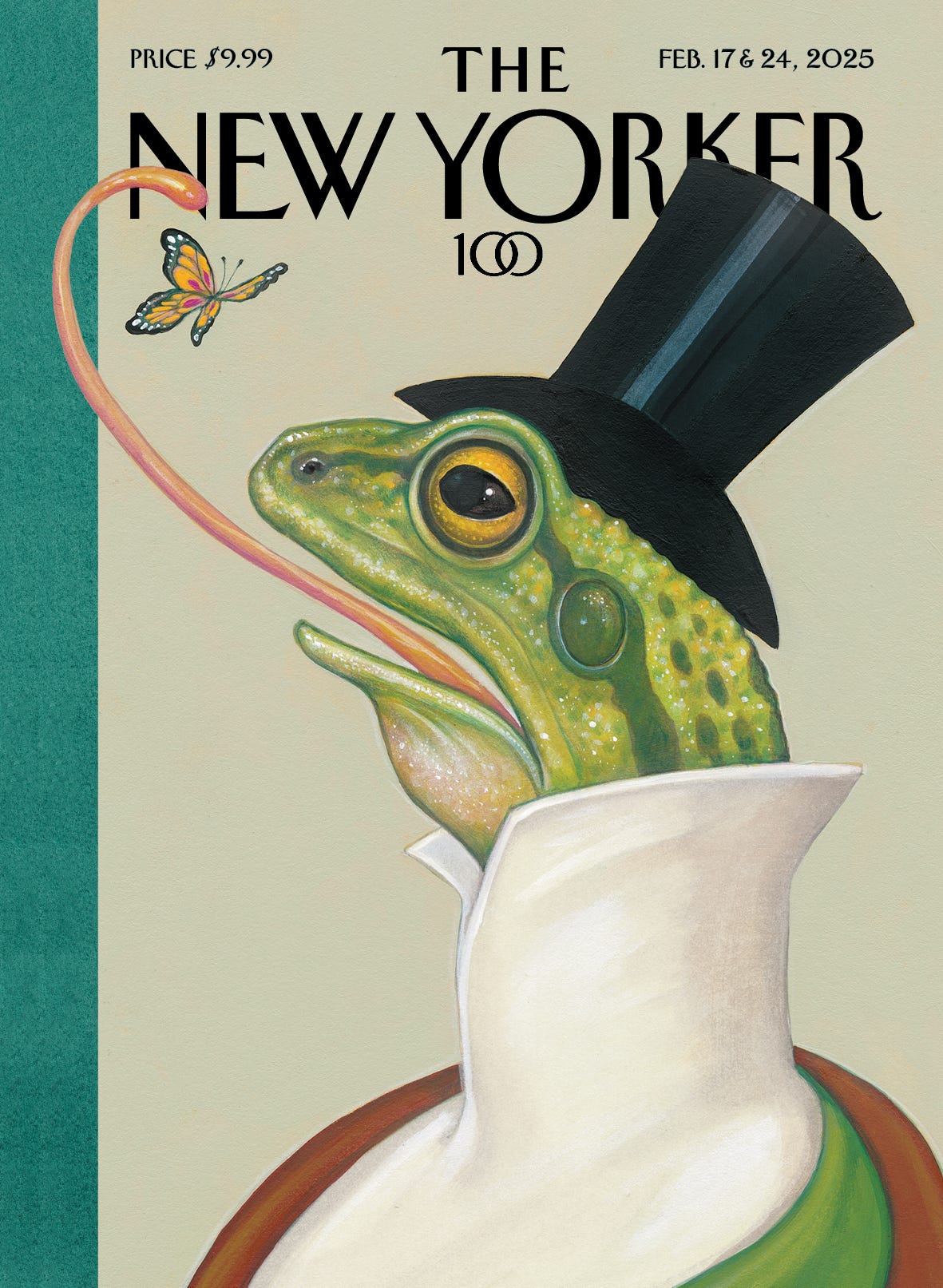#35 – Infinitely Inspiring Art of Anita Kunz
On her New Yorker covers, recent projects and early years of her career
This is My Year With The New Yorker Part 3.
It’s a rare sunny morning of winter in Toronto when I connected with Anita Kunz to ask her about her New Yorker covers. A long-time contributor to the magazine, Kunz has created one of six covers for The New Yorker’s centenary issue. Kunz’s cover is striking: Eustace Tilley turns into a high-collared frog making a short work of a fluttering butterfly. The image feels like a natural extension of Kunz’s rich repertoire that is imaginative, illuminating and sometimes irreverent. In 2021, Kunz published “Another History of Art,” in which she reimagines the most iconic paintings in the history of art as if they had been painted by women. A collection of beautifully rendered artwork, the book is also a commentary on the male-dominated history of Western civilization.
Over the past five years, Kunz has been working on “Original Sisters: Portraits of Tenacity and Courage,” a project born during the COVID pandemic. In March 2020, locked down in her home studio in Toronto and looking for inspiration, Kunz started researching unsung women who achieved remarkable success but have not been fully recognized in history. Since 2020, Kunz has painted 500 portraits of extraordinary women—from Joan of Arc to Josephine Baker to lesser-known women such as anti-Nazi activist Sophie Scholl and Alice Ball, a young African American scientist who discovered a treatment for leprosy. An exhibition is currently on at the Norman Rockwell Museum to celebrate the Original Sisters.
“Everything I do, whether it’s for this project, for The New Yorker, or for something else, has some kind of social or political content,” says Kunz.
Kunz graduated from Ontario College of Art & Design (OCAD) University in 1978. Inspired by her uncle whose motto was “Art for Education,” she has always known that she wanted to be an artist. “I like all kinds of art, but what has always moved me the most is art that can, at least, start a conversation. Art can bear witness. Art can rebel. Art can help as a form of therapy.”

Kunz recalls that she started out her career by doing advertising jobs around Toronto. “I did cat food ads, I did pizza ads, I did ads for a fishing lure company. Just anything I could find to pay the bills,” she says. Kunz also contributed to prominent Canadian magazines such as Maclean’s and Saturday Night. Eventually, she started expanding her clientele south of the border. In the late ’80s, Kunz was one of two artists chosen by Rolling Stone to produce a monthly illustrated History of Rock ‘n Roll end paper.
For The New Yorker’s issue of July 10, 1995, Kunz contributed her first cover to the magazine—a man with a mohawk that resembles the skyline of New York City. Since then, she has been a regular contributor to The New Yorker with bold and evocative covers. For the issue of July 30, 2007, Kunz created “Girls Will Be Girls,”— a depiction of three women, one in a burka, one in skimpy clothes, and one a nun. (“I wanted to do a play with the eyes, so the two women who are the most covered are the ones who actually see.”)
For The New Yorker’s ninetieth anniversary ten years ago, Kunz re-interpreted Eustace as a ’70s hippy smoking a marijuana cigarette. (“I thought that one is probably not going to make it to the cover, but it did.”) For the magazine’s centenary this year, Kunz turned Eustace’s character into Mr. Froggy. “Françoise [the art editor of The New Yorker] is very visual; you can send her a very rough sketch, and she is able to immediately understand what you are trying to express.”
Over the years, Kunz has produced cover art for many publications, including Time, Sports Illustrated, Newsweek, Rolling Stone, The New Yorker, The Atlantic and The New York Times Magazine. In 2009, Kunz was appointed as an Officer of the Order of Canada "for her contributions as an illustrator whose insightful works have graced publications around the world.” A recipient of three honorary doctorate degrees, Kunz was inducted into the Museum of American Illustration Hall of Fame in New York in 2017.
At the end of our conversation, I couldn’t help asking: Did she have a moment where it felt like a breakthrough, after which things became different?
“No, not really,” says Kunz. “It was great when I started getting regular work, and I knew that, okay, this might work. In some ways, that's kind of the hardest part: how to do work that's meaningful to you and thrive as an artist, but also you have to pay bills and figure out a way to do that without compromising too much, you know. So, it's always a balancing act.”
PS: I also asked Kunz my favorite question: “What is your favorite thing about The New Yorker?”
Kunz said: “The New Yorker goes in depth into their subjects, and they publish great articles. They also publish a lot of great art, and art that isn't always just on the cover. When I get a new issue, I typically go through it a few times. First, I read the cartoons. Then I tend to read the shorter articles and then finally the longer in-depth ones. It’s kind of a ritual for me. The combination of subject matter and subject diversity makes the magazine rich and always interesting.”






The Girls Will be Girls cover is SO good—hard to look away from it.
Also, Kunz's work sounds interesting. I'll be looking up more of it now. Thanks for highlighting this, Saran!
The 'Girls Will Be Girls' piece is so thought-provoking. Spent a lot of time staring at it and pondering over all the metaphors it could carry. Loved this Saran!